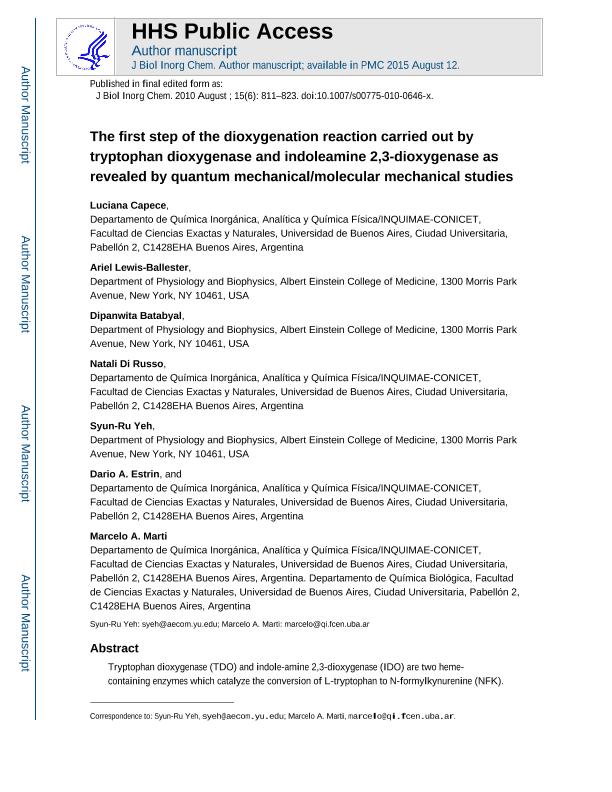Artículo
The first step of the dioxygenation reaction carried out by tryptophan dioxygenase and indoleamine 2,3-dioxygenase as revealed by quantum mechanical/molecular mechanical studies
Capece, Luciana ; Lewis Ballester, Ariel; Batabyal, Dipanwita; Di Russo, Natali; Yeh, Syun Ru; Estrin, Dario Ariel
; Lewis Ballester, Ariel; Batabyal, Dipanwita; Di Russo, Natali; Yeh, Syun Ru; Estrin, Dario Ariel ; Marti, Marcelo Adrian
; Marti, Marcelo Adrian
 ; Lewis Ballester, Ariel; Batabyal, Dipanwita; Di Russo, Natali; Yeh, Syun Ru; Estrin, Dario Ariel
; Lewis Ballester, Ariel; Batabyal, Dipanwita; Di Russo, Natali; Yeh, Syun Ru; Estrin, Dario Ariel ; Marti, Marcelo Adrian
; Marti, Marcelo Adrian
Fecha de publicación:
08/2010
Editorial:
Springer
Revista:
Journal of Biological Inorganic Chemistry
ISSN:
0949-8257
Idioma:
Inglés
Tipo de recurso:
Artículo publicado
Clasificación temática:
Resumen
Tryptophan dioxygenase (TDO) and indoleamine 2,3-dioxygenase (IDO) are two heme-containing enzymes which catalyze the conversion of L-tryptophan to N-formylkynurenine (NFK). In mammals, TDO is mostly expressed in liver and is involved in controlling homeostatic serum tryptophan concentrations, whereas IDO is ubiquitous and is involved in modulating immune responses. Previous studies suggested that the first step of the dioxygenase reaction involves the deprotonation of the indoleamine group of the substrate by an evolutionarily conserved distal histidine residue in TDO and the hemebound dioxygen in IDO. Here, we used classical molecular dynamics and hybrid quantum mechanical/molecular mechanical methods to evaluate the base-catalyzed mechanism. Our data suggest that the deprotonation of the indoleamine group of the substrate by either histidine in TDO or heme-bound dioxygen in IDO is not energetically favorable. Instead, the dioxygenase reaction can be initiated by a direct attack of heme-bound dioxygen on the C 2=C 3 bond of the indole ring, leading to a protein-stabilized 2,3-alkylperoxide transition state and a ferryl epoxide intermediate, which subsequently recombine to generate NFK. The novel sequential two-step oxygen addition mechanism is fully supported by our recent resonance Raman data that allowed identification of the ferryl intermediate (Lewis-Ballester et al. in Proc Natl Acad Sci USA 106:17371-17376, 2009). The results reveal the subtle differences between the TDO and IDO reactions and highlight the importance of protein matrix in modulating stereoelectronic factors for oxygen activation and the stabilization of both transition and intermediate states. © SBIC 2010.
Archivos asociados
Licencia
Identificadores
Colecciones
Articulos(INQUIMAE)
Articulos de INST.D/QUIM FIS D/L MATERIALES MEDIOAMB Y ENERGIA
Articulos de INST.D/QUIM FIS D/L MATERIALES MEDIOAMB Y ENERGIA
Citación
Capece, Luciana; Lewis Ballester, Ariel; Batabyal, Dipanwita; Di Russo, Natali; Yeh, Syun Ru; et al.; The first step of the dioxygenation reaction carried out by tryptophan dioxygenase and indoleamine 2,3-dioxygenase as revealed by quantum mechanical/molecular mechanical studies; Springer; Journal of Biological Inorganic Chemistry; 15; 6; 8-2010; 811-823
Compartir
Altmétricas



